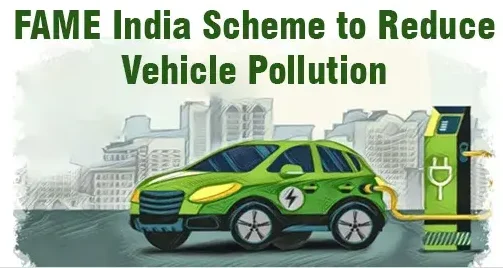As the world moves towards sustainable energy solutions, India has been making significant strides in promoting electric mobility. One of the key initiatives driving this transformation is the Faster Adoption and Manufacturing of Electric Vehicles (FAME) subsidy program. Introduced in 2015, this government-backed scheme aims to reduce dependency on fossil fuels, curb vehicular emissions, and make electric vehicles (EVs) more accessible to consumers. Over the years, the FAME subsidy has evolved through multiple phases, with FAME-II currently in operation and FAME-III expected to launch in 2025. This guide provides an in-depth look at the objectives, benefits, eligibility criteria, and the latest developments surrounding the FAME subsidy in India.
Understanding the FAME Subsidy and Its Significance
The FAME subsidy is part of India’s broader National Electric Mobility Mission Plan (NEMMP), designed to accelerate the adoption of electric vehicles while simultaneously fostering the development of EV infrastructure, including charging stations. By providing financial assistance to EV buyers and manufacturers, the scheme aims to create a cleaner and more energy-efficient transportation ecosystem in the country. The FAME initiative is being implemented in a phased manner to ensure a structured and effective transition from conventional fuel-powered vehicles to electric mobility.
Over the years, the scheme has been executed in three distinct phases:
FAME-I (2015-2019): The initial phase focused on encouraging early EV adoption by offering purchase incentives, supporting pilot projects, and funding research and development initiatives.
FAME-II (2019-2025): The second phase, which is currently operational, has expanded its scope by offering greater financial incentives, subsidizing public transport electrification, and enhancing EV charging infrastructure across the country.
FAME-III (Expected 2025): The upcoming phase is likely to focus on further strengthening the EV ecosystem with a higher budget allocation and new policy measures to boost electric vehicle manufacturing and adoption.
FAME-I: The First Phase of India’s Electric Mobility Journey
The first phase of the FAME scheme, launched in 2015, marked India’s initial steps toward the widespread adoption of electric mobility. With a budget allocation of ₹895 crores, the primary objective of FAME-I was to create awareness and generate interest in electric vehicles among consumers. The government provided direct financial incentives to buyers of electric two-wheelers, three-wheelers, and hybrid vehicles, making them more affordable and accessible.
Additionally, the first phase supported the installation of 425 charging stations across key cities, addressing one of the major challenges in EV adoption—charging infrastructure. By the end of this phase in 2019, over 2.8 lakh electric vehicles had benefited from the subsidy, laying the foundation for India’s growing EV market.
FAME-II: The Current Phase Driving India’s EV Growth
The second phase of the FAME scheme, known as FAME-II, was introduced in 2019 with a significantly increased budget of ₹10,000 crores. The primary focus of this phase is to accelerate the mass adoption of electric mobility, particularly in the public and commercial transport sectors. Initially planned for three years, the government later extended the program until March 2025 to continue supporting EV growth.
Key Features of FAME-II
One of the most notable aspects of FAME-II is its focus on increasing the number of electric vehicles on Indian roads while simultaneously investing in charging infrastructure and local manufacturing. The scheme provides financial subsidies for different categories of EVs, including electric two-wheelers (E2Ws), electric three-wheelers (E3Ws), electric four-wheelers (E4Ws) for fleet and commercial use, and electric buses.
For instance, electric two-wheelers receive an incentive of ₹15,000 per kilowatt-hour (kWh) of battery capacity, with the total subsidy covering up to 40% of the vehicle’s cost. Similarly, electric three-wheelers and electric four-wheelers receive incentives based on their battery capacity, ensuring affordability for a wide range of users. Additionally, electric buses used in public transport are provided subsidies of ₹20,000 per kWh of battery capacity, encouraging state governments and private operators to transition towards zero-emission public transport solutions.
Eligibility Criteria for Availing FAME-II Benefits
To qualify for FAME-II subsidies, both buyers and vehicles must meet specific eligibility criteria. The primary conditions include:
For Buyers: The individual must possess a valid identity proof such as an Aadhaar Card, PAN Card, or Passport. The name on the identity proof must match the vehicle registration details, and the buyer should not have previously claimed the subsidy for another electric vehicle purchase.
For Vehicles: Eligible vehicles must be registered in India and meet minimum performance standards in terms of battery range, safety, and energy efficiency. Electric two-wheelers, for example, must have a minimum range of 80 km per charge, ensuring practical usability for daily commuting. Moreover, only government-approved EV models qualify for the subsidy under the FAME-II scheme.
Impact of FAME-II on India’s EV Sector
Since its implementation, FAME-II has had a profound impact on the Indian electric vehicle industry. More than 7 lakh electric vehicles have been subsidized under the scheme, with a growing share of electric buses, three-wheelers, and fleet vehicles. The government has also approved the installation of 2,877 charging stations to address infrastructure challenges, making EV adoption more convenient for consumers. Furthermore, the initiative has played a crucial role in reducing India’s carbon footprint by encouraging the shift from petrol and diesel vehicles to eco-friendly electric alternatives.
FAME-III: The Next Phase of India’s EV Evolution
With FAME-II set to conclude in March 2025, the Indian government is working on rolling out FAME-III, which is expected to introduce new and enhanced incentives for electric vehicle adoption. The budget for FAME-III is anticipated to be around ₹10,000 crores, similar to its predecessor. However, this phase is expected to prioritize commercial EVs, battery technology development, and expanding charging infrastructure.
What to Expect from FAME-III?
Greater incentives for commercial electric vehicles, including e-rickshaws, electric delivery vans, and fleet operators.
Expansion of charging networks across highways and urban centers to support long-distance EV travel.
Increased focus on local manufacturing of EV components, such as lithium-ion batteries and powertrains, to reduce reliance on imports.
Possible inclusion of passenger electric cars, which were largely excluded from direct subsidies under FAME-II.
State-Level EV Incentives Complementing FAME
In addition to the FAME subsidy, several Indian states have introduced their own EV policies to further encourage adoption. Some states provide additional purchase incentives, road tax exemptions, and registration fee waivers. Notable states leading the EV transition include Delhi, Maharashtra, Gujarat, and Tamil Nadu, which have implemented comprehensive policies to support both consumers and manufacturers in the EV space.
Conclusion: The Future of Electric Mobility in India
The FAME subsidy has been instrumental in accelerating India’s transition to electric vehicles, making them more accessible and affordable. With FAME-II currently active and FAME-III on the horizon, India is on the path to becoming a global leader in electric mobility. As technology advances and government policies continue to evolve, the EV ecosystem in India is poised for significant growth in the coming years. The ongoing support from the government, coupled with increased consumer awareness and improved infrastructure, will likely drive the widespread adoption of electric vehicles, ensuring a greener and more sustainable future for the country.

